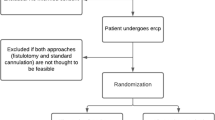Abstract
Background
During endoscopic retrograde cholangiopancreatography (ERCP), incising through the wall of the major papilla with an electrocautery needle-knife is a method for achieving access into the bile duct. This procedure, often referred to as a “precut,” may be used when cannulation attempts via the orifice of the papilla are unsuccessful. Potential complications include hemorrhage, duodenal perforation, and acute pancreatitis.
Methods
The 172 patients who underwent an attempt of a needle-knife assisted ERCP during the years 1997–2003 at our institution were retrospectively evaluated.
Results
A selective bile duct cannulation was achieved after needle-knife incision in 148 out of 172 patients (86%) at the primary session. In 10 additional patients (6%), a repeated procedure proved successful for cannulation. In the remaining 14 patients (8%), the biliary cannulation failed and was not attempted again. Complications after needle-knife assisted ERCP occurred as follows: three patients (2%) presented with late bleeding after the ERCP and three patients (2%) developed acute pancreatitis. None of the patients required operative treatment for complications. There was no mortality.
Conclusion
The use of the needle-knife markedly improves the success rate of selective biliary cannulation in ERCP without increasing the rate of complications.
Similar content being viewed by others
References
Andriulli A, Solmi L, Loperfido S, Leo P, FestaV, Belmonte A, Spirito F, Silla M, Forte G, Terruzzi V, Marenco G, Ciliberto E, Sabatino A, Monica F, Magnolia MR, Perri F (2004) Prophylaxis of ERCP related pancreatitis: a randomized, controlled trial or somatostatin and gabexate mesilate. Clin Gastroenterol Hepatol 2: 713–718
Bruins Slot W, Shoeman MN, Disario JA, Wolters F, Tytgat G, Huibregtse K (1996) Needle-knife sphincterotomy as a precut procedure: a retrospective evaluation of efficacy and complications. Endoscopy 28: 334–339
Carr-Locke DL (2004) Biliary access during endoscopic retrograde cholangiopancreaticography. Can J Gastroenterol 18: 251–254
Cotton P (1989) Precut sphincterotomy: a risk technique for experts only. Gastrointest Endosc 35: 578–579
Dhir V, Swaroop VS, Mohandas KM, Jagannath P, Desouza LJ (1997) Precut papillotomy using a needle-knife: experience in 100 patients with malignant obstructive jaundice. Indian J Gastroenterol 16: 52–53
Foutch PG (1995) A prospective assessment of results for needle-knife papillotomy and standard endoscopic sphincterotomy. Gastrointest Endosc 41: 25–32
Freeman ML, Nelson DB, Sherman S, Haber GB, Herman ME, Dorsher PJ, Moore JP, Fennerty MB, Ryan ME, Shaw MJ, Lande JD, Pheley AM (1996) Complications of endoscopic biliary sphincterotomy. N Engl J Med 335: 909–918
Huibregtse K, Katon R, Tytgat G (1986) Precut papillotomy via fine-needle knife papillotomy: a safe and effective technique. Gastrointest Endosc 32: 403–405
Katsinelos P, Mimidis K, Paroutoglou G, Christodoulou K, Pilpilidis I, Katsiba D, Kalomenopoulou M, Papagiannis A, Tsolkas P, Kapitsinis I, Xiarchos P, Beltsis A, Eugenidis N (2004) Needle-knife papillotomy: a safe and effective technique in expert hands. Hepato-Gastroenterol 5: 349–352
Lella F, Bagnolo F, Colombo E, Bonassi U (2004) A simple way of avoiding post-ERCP pancreatitis. Gastrointest Endosc 59: 830–834
Mavrogiannis C, Liatsos C, Romanes A, Petoumenos C, Nakos A, Karvountzis G (1999) Needle-knife fistulotomy versus needle knife precut papillotomy for the treatment of common bile duct stones. Gastrointest Endosc 50: 334–339
Maydeo A, Borkar D (2003) Techniques of selective cannulation and sphincterotomy Endoscopy 35: 19–23
Siegel JH, Ben-Zvi JS, Pullano W (1989) The needle-knife: a valuable tool in diagnostic and therapeutic ERCP. Gastrointest Endosc 35: 499–503
Author information
Authors and Affiliations
Corresponding author
Rights and permissions
About this article
Cite this article
Gullichsen, R., Lavonius, M., Laine, S. et al. Needle-knife assisted ERCP. Surg Endosc 19, 1243–1245 (2005). https://doi.org/10.1007/s00464-004-2281-5
Received:
Accepted:
Published:
Issue Date:
DOI: https://doi.org/10.1007/s00464-004-2281-5




